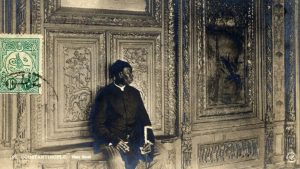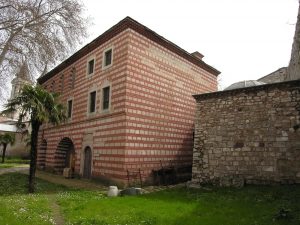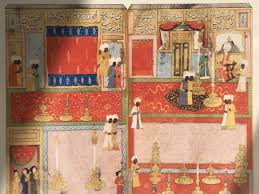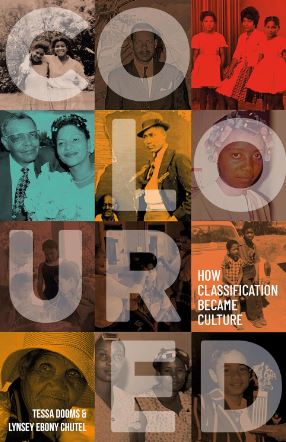Siyah: Black Eunuchs: The Case of Bashir Agha
This personal piece authored by Zeinab Suleiman focuses on the life of Bashir Agha, a prominent African eunuch during slavery in the Ottoman Empire, and what his life can tell us about the treatment of Black eunuchs in the imperial court. It’s the third instalment in ‘Siyah’, a series exploring the relationship between the African Diaspora and Turkish social and cultural narratives, with journalist Adama Juldeh Munu.

Istanbul is an exciting city for history buffs and those who are inquisitive about the past. The Ottoman Empire’s splendour and opulence can be visibly seen in the magnificent mosques and palaces dotted around the city, like the Topkapi Palace – a must-see attraction. It served as the main residence and administrative centre of Ottoman sultans. I was motivated by a discovery that there were Black eunuchs in the Ottoman Empire. Like every other empire, it too had its fair share of trading enslaved Africans.

Some affluent African eunuchs lived amidst the sultanate residency and beyond, at the peak of Ottoman power, even at Topkapi. This affluence is manifested visibly in the splendour of the quarters the slaves lived in. However, the enslaved had a purpose and were selected accordingly – a process they would have undergone before they occupied their places in the palace. The consequence was the creation of an ‘otherness’ of the African among those living and working within the harem. Similar to the breeding process inherent in US and South American chattel slavery, the young, healthy and strong were selected for field work and breeding. Black eunuchs were deliberately chosen for being ‘unattractive’ to discourage any sexual interactions with Caucasian women servants for instance. Additionally, they were made impotent through castration. It was reported in detail by John Burckhardt who visited Upper Egypt and Nubia in the early 19th century, howevere did not witness the operation in person.
“…the young man was held down on top of the table while his genitalia were tied off with ‘soap coated silken cord’ they were then swiftly cut off with a razor. Following surgery, a wooden or (then) tin tube was inserted into the Eunuch’s urethra, the wound was cauterised with ash and hot sand, then slightly later with boiling oil ….”
According to George Junne’s The Black Eunuchs of the Ottoman Empire: Networks of power in the court of the Sultan, there may have been around 800 court Black eunuchs that were taught Turkish, also receiving instruction in religion, court manners and discipline. Enslaved boys would have been under the supervision of the chief Black eunuch, whose role at times was as high as that of the prime minister. The chief Black eunuch was affluent and influential enough to be an advisor, carry responsibility for the education of the princes and would have close links to the sultan. One of the longest serving chief Black eunuchs was Bashir Agha (1657-1746).
Agha’s story is one of resilience, having emerged from the brutal vortex of the African slave trade, torn from his home in Abyssinia from a young age. He survived castration and went on to serve in a prominent house in Cairo. He was later transferred to Istanbul and soon became a rather affluent individual. He occupied the office of the Chief Eunuch for 29 years, longer than any other before and after him. Agha became so powerful that he could influence the selection, patronage and dismissals of prime ministers, and kept an eye on the conflicts between rival claimants for office.
He not only influenced Ottoman court culture, it is said he played a key role in shaping Ottoman Sunni Islam. He was appointed Chief Eunuch of the Prophet’s tomb in Medina and supervised the imperial religious patronages in Medina and Mecca, sponsoring libraries and Qur’an schools throughout the empire.
Agha was an adherent of the Hanafi school (one of four Islamic legal schools of thought and practice) which was the main legal practice of Islam in the Ottoman Empire. However, it is argued Agha actively supported Sufi orders [Sufi orders refer to the practice and philosophical tradition in Islam that relates to spiritualism] and the structures in which they practiced their rituals. This took place during a time when the orders were under attack by puritanical movements during the 17th century. By the 18th century some Sufi sects flourished, with much credit awarded to Agha for his intervention through his widespread promotion of the study of the Prophet’s sayings, and providing a collection of and commentaries about the sayings in his numerous libraries. According to Professor Jane Hathaway: “Bashir Agha, who came to the Ottoman palace as a gelding slave, left his mark on history as a Sunni Muslim master, a statesman, a Sufi, and a book lover at the end of his long life.”

Agha’s legacy still stands among the architectures of Istanbul and Cairo, including mosques, schools, fountains, and more so, his vast collection of books which are preserved in the Suleymaniye library in Istanbul. In my walks in the Sultanahmet area which contains the Hagia Sopha mosque, I stumbled upon one of his buildings – the Haji Bashir Agha Mosque. The mosque contains a beautiful fountain and courtyard built in 1745. He also built a fountain on the Divan Yolu, an ancient road in Istanbul, and another one in Eyup, Istanbul.
My excitement in discovering this amazing man’s contribution – not only to the Ottoman Empire but to the Islamic world – had me contacting Professor Jane Hathaway and thanking her for her work. It was like two schoolgirls talking about their favourite pop musician; Jane was equally glad that someone else had discovered Agha. Bashir Agha’s contributions served the course of history, for their contribution to humanity and civilisation, despite the inhumane nature in which they came to be in Turkey.
However prominent chief Black eunuchs were, they remained outside Ottoman society and were not integrated. And this became more pronounced during the 19th century when the international slave trades were abolished. They became, as Junne puts it, an “embarrassing relic of a corrupted old order”, thus by the time Ottoman rule ended in 1923, court eunuchs virtually had no role.



